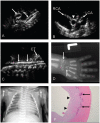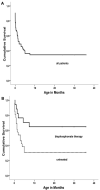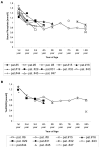Hypophosphatemia, hyperphosphaturia, and bisphosphonate treatment are associated with survival beyond infancy in generalized arterial calcification of infancy
- PMID: 20016754
- PMCID: PMC2794045
- DOI: 10.1161/CIRCGENETICS.108.797704
Hypophosphatemia, hyperphosphaturia, and bisphosphonate treatment are associated with survival beyond infancy in generalized arterial calcification of infancy
Abstract
Background: Generalized arterial calcification of infancy has been reported to be frequently lethal, and the efficiency of any therapy, including bisphosphonates, is unknown. A phosphate-poor diet markedly increases survival of NPP1 null mice, a model of generalized arterial calcification of infancy.
Methods and results: We performed a multicenter genetic study and retrospective observational analysis of 55 subjects affected by generalized arterial calcification of infancy to identify prognostic factors. Nineteen (34%) patients survived the critical period of infancy. In all 8 surviving patients tested, hypophosphatemia due to reduced renal tubular phosphate reabsorption developed during childhood. Eleven of 17 (65%) patients treated with bisphosphonates survived. Of 26 patients who survived their first day of life and were not treated with bisphosphonates only 8 (31%) patients survived beyond infancy. Forty different homozygous or compound heterozygous mutations, including 16 novel mutations in ENPP1, were found in 41 (75%) of the 55 patients. Twenty-nine (71%) of these 41 patients died in infancy (median, 30 days). Seven of the 14 (50%) patients without ENPP1 mutations died in infancy (median, 9 days). When present on both alleles, the mutation p.P305T was associated with death in infancy in all 5 cases; otherwise, no clear genotype-phenotype correlation was seen.
Conclusion: ENPP1 coding region mutations are associated with generalized arterial calcification of infancy in approximately 75% of subjects. Except for the p.P305T mutation, which was universally lethal when present on both alleles, the identified ENPP1 mutations per se have no discernable effect on survival. However, survival seems to be associated with hypophosphatemia linked with hyperphosphaturia and also with bisphosphonate treatment.
Keywords: genetics; mortality; pediatrics; prognosis; survival.
Figures




References
-
- Moran JJ. Idiopathic arterial calcification of infancy: a clinicopathologic study. Pathol Annu. 1975;10:393–417. - PubMed
-
- Rutsch F, Schauerte P, Kalhoff H, Petrarulo M, August C, Diekmann L. Low levels of urinary inorganic pyrophosphate indicating systemic pyrophosphate deficiency in a boy with idiopathic infantile arterial calcification. Acta Paediatr. 2000;89:1265–1269. - PubMed
-
- Spear R, Mack LA, Benedetti TJ, Cole RE. Idiopathic infantile arterial calcification, in utero diagnosis. J Ultrasound Med. 1990;9:473–476. - PubMed
-
- Whitehall J, Smith M, Altamirano L. Idiopathic infantile arterial calcification: sonographic findings. J Clin Ultrasound. 2003;31:497–501. - PubMed
Publication types
MeSH terms
Substances
Grants and funding
LinkOut - more resources
Full Text Sources
Other Literature Sources
Medical
Molecular Biology Databases
Miscellaneous

